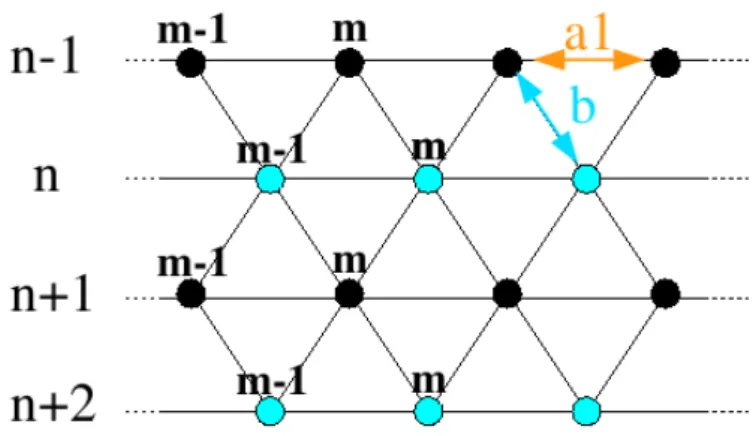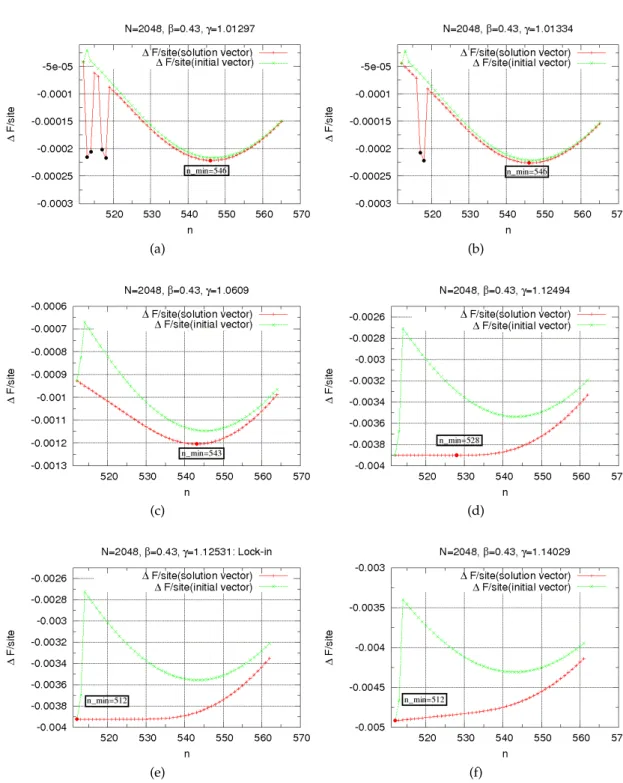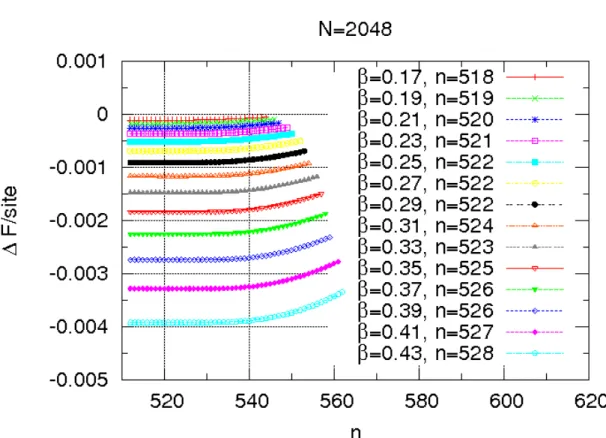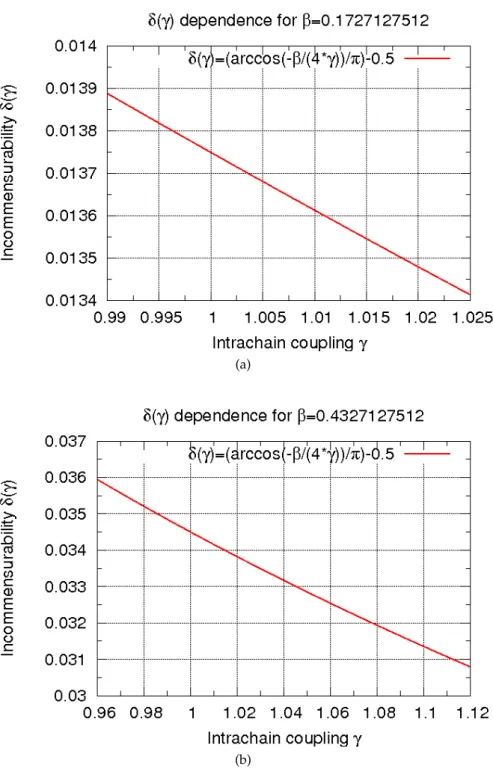Diploma Thesis
Non-conventional spin-Peierls phase in titanium oxyhalogenides
Eva Bömer March 30, 2010
Lehrstuhl für Theoretische Physik I Fakultät für Physik
Technische Universität Dortmund
Typeset using L
ATEX and
KOMA - Script.Contents
1 Abstract 7
2 Introduction 9
2.1 From crystalline solids to antiferromagnetic quantum spin systems . . . . 9
2.2 Low-dimensional quantum spin systems . . . . 10
2.3 Néel and RVB states . . . . 11
2.4 Unfrustrated antiferromagnetic spin S=1/2 Heisenberg chain . . . . 12
2.4.1 Spin-Peierls transition . . . . 14
2.4.2 Incommensurably modulated phases . . . . 15
2.4.2.1 Spatial dependence of the soliton excitations . . . . 17
3 Physics of the titanium oxyhalogenides 21
3.1 Structure of the titanium oxyhalogenides . . . . 21
3.2 Spin-Peierls like behavior . . . . 25
3.3 Phase transitions . . . . 25
3.4 Commensurate and incommensurate phase . . . . 28
3.5 Interchain frustration as an explanation for the incommensurability along the chains . . . . 30
4 Description of the incommensurate phase and the phase transition to the commen- surate phase in a simplified one-dimensional model 35
4.1 Simplified one-dimensional model for the description of the incommensu- rate phase and the lock-in transition . . . . 36
4.1.1 Structure of the implemented program . . . . 37
4.1.2 Optimal initial vectors . . . . 38
4.1.3 Calculation of the incommensurability
δ. . . . 46
4.1.4 Parameter analysis . . . . 48
4.1.4.1 Calculation of the onset parameter
γc=
γ( T
c2) . . . . 48
4.1.4.2 Calculation of the lock-in parameter
γl=
γ( T
c1) . . . . . 50
4.1.4.3 Determination of the parameters
βand
αdescribing the experimental data . . . . 51
4.2 Results and discussion . . . . 55
4.2.1 Spatial dependence of the displacements . . . . 55
4.2.1.1 Display of the solutions . . . . 55
4.2.1.2 Solutions in the commensurate and incommensurate phase 56
4.2.2 Discussion of the
γc(
β) and
γl(
β) dependencies . . . . 65
4.2.3 Intrachaincoupling and temperature dependence of the incommen- surability
δ. . . . 67 4.2.4 Study of the 1-kink-solution . . . . 70 4.2.4.1 Formation energy of a soliton: 1-kink-energy
∆E1kink. . . 70 4.2.4.2 Soliton energy
∆W . . . . 75 4.2.4.3 Spatial extent of a soliton . . . . 80 4.2.4.4 Soliton energy and the incommensurability
δ. . . . 86
5 Conclusion and Outlook 97
Appendix 101
A.1 Computational details . . . 101
List of Figures
2.1 Unfrustrated and frustrated lattices . . . . 10
2.2 Néel state and RVB state . . . . 11
2.3 Goldstone bosons . . . . 11
2.4 Frustrated triangle loop . . . . 12
2.5 Spinon in Néel or RVB state . . . . 13
2.6 Spinon creation in the scope of periodic boundary conditions . . . . 13
2.7 Spin-Peierls distortion . . . . 15
2.8 Adaptive solution for the local displacements
Φiand the local magnetiza- tions m
iin incommensurably modulated phases . . . . 16
3.1 Structure of TiOCl . . . . 22
3.2 3d orbitals in TiOCl . . . . 23
3.3 Linear chains of d
xyand zigzag chains of d
xzorbitals in TiOCl . . . . 24
3.4 Magnetic susceptibility of TiOCl and TiOBr . . . . 26
3.5 Thermal expansion and specific heat of TiOCl and TiOBr . . . . 27
3.6 X-ray diffraction data for superlattice reflections in the commensurate and incommensurate phase in TiOCl . . . . 28
3.7 Experimental temperature dependence of the incommensurabilities along and perpendicular to the chains in TiOCl . . . . 29
3.8 Displacements in the twofold spin-Peierls state . . . . 30
3.9 Two-dimensional modell of a system of frustrated Ti spin chains . . . . 31
4.1 Simplification of two frustrated spin chains to a single spin chain with frus- trated next nearest neighbor coupling . . . . 36
4.2 Initial vectors for the spatial dependence of the displacements with and without phase shift . . . . 40
4.3 Initial vector dependence of the free energy . . . . 44
4.4 High resolved initial vector dependence of the minimized free energy just before the lock-in . . . . 45
4.5 Experimental temperature dependence of the incommensurability
δ. . . . 52
4.6 Interchain coupling dependence of the analytically determined incommen- surability . . . . 54
4.7 Spatial dependence of the displacements in the commensurate and incom- mensurate phase . . . . 55
4.8 Modified spatial dependence of the displacements in the commensurate
and incommensurate phase . . . . 56
4.9 Displacements in the commensurate phase . . . . 57
4.10 Displacements in the incommensurate phase . . . . 57
4.11 Spatial dependence of the displacements for various intrachain couplings for
β= 0.1727127512 . . . . 59
4.12 Spatial dependence of the displacements for various intrachain couplings for
β= 0.4327127512 . . . . 62
4.13 Numerical and analytical values for the onset parameter
γcand the lock-in parameter
γl. . . . 65
4.14 Numerical values for the onset parameter
γcand the lock-in parameter
γlfor various values of the parameter a
0. . . . 66
4.15 Experimental temperature dependence of the incommensurability
δ. . . . 67
4.16 Numerically determined temperature dependence of the incommensura- bility
δfor various interchain couplings
β. . . . 68
4.17 Numerically determined interchain coupling dependence of the incom- mensurability
δfor various interchain couplings
β. . . . 69
4.18 Intrachain coupling dependence of the 1-kink-energy
∆E1kink. . . . 70
4.19 Linear intrachain coupling dependence of the 1-kink-energy
∆E
1kinkclose to the lock-in . . . . 71
4.20 Spatial dependence of the displacements in the 1-kink-solution . . . . 72
4.21 Comparison of
γl-values determined by the study of the modulation wave vector or the 1-kink-energy . . . . 74
4.22 Inter-soliton spacing dependence of the soliton energy
∆W. . . . 76
4.23 Spatial extent of a soliton . . . . 83
4.24 Incommensurability dependence of the soliton energy
∆W. . . . 87
4.25 Comparison of the incommensurabilities
δand
δopt,∆Wdetermined by the examination of the modulation wave vector or the soliton energy . . . . . 91
4.26 Fit of the approximated solution for
δoptto the numerical results for the incommensurability
δopt,∆W. . . . 93
4.27 Comparison of the approximated solution for
δoptand the numerically de- termined values for
δopt,f(δ). . . . 94
4.28 Numerically determined values for
δopt,∆Wand
δopt,f(δ). . . . 95
1 Abstract
Low-dimensional S = 1/2 quantum spin systems are a fascinating playground for the- oretical and experimental solid state research. These systems are strongly correlated and exhibit magnetic order in a variety of ground states. A multitude of degrees of freedom such as charge, spin, orbital and lattice degrees of freedom may be involved. The reduc- tion of the spatial degrees of freedom to one or two space direction leads to interesting phenomena at low temperatures and their coupling to the crystal lattice may imply a breaking of certain symmetries. Furthermore, quantum fluctuations play a more impor- tant role than in higher-dimensional systems.
Especially frustrated systems are interesting, where competing interactions favor differ- ent magnetic ground states and where exotic phase transitions can be observed.
A very fascinating phenomenon is the Peierls instability of quasi one-dimensional met- als against a lattice modulation with a modulation wave vector 2k
F, the doubled Fermi wave vector [1, 2]. For an electronic system with partly filled conduction band it is en- ergetically favorable to reduce the crystal symmetry and to open an energy gap at the Fermi edge. The energy cost due to the lattice deformation is overcome by the gain of electronic energy due to the reduction of the Brillouin zone and the corresponding ener- getic lowering of the occupied states nearby the Fermi edge. In case of half band filling, the Peierls-instability leads to a dimerization of the system, i.e., to a doubling of the unit cell and, therewith, a breaking of the translation symmetry.
Since one-dimensional Fermi operators can be mapped on spin operators via Jordan- Wigner transformation [3], an analogous phenomenon is expected to appear in one- di- mensional spin systems. The possibility of the existence of such a spin-Peierls instability has been discussed already in the sixties. Indeed, in 1975, Bray et al. [4, 5] observed a spin- Peierls transition from a quasi one-dimensional spin S = 1/2 chain coupled to the lattice to a dimerized non-magnetic ground state in the organic compounds TTFCuS
4C
4(CF
3)
4and TTFCuBDT. With CuGeO
3the first inorganic spin-Peierls compound was found in 1993 [6]. Since then the understanding of spin-Peierls systems has substantially deep- ened.
In recent years the titanium oxyhalogenides became subject to research as they are be- lieved to be another inorganic spin-Peierls compound. However, there are some experi- mental facts, which go clearly beyond a canonical spin-Peierls scenario, suggesting even richer physics in these compounds.
In canonical spin-Peierls systems, there is a single second order phase transition to a
dimerized ground state. Applying sufficiently high magnetic fields leads to a phase tran-
sition to an incommensurably modulated phase [7].
In the titanium oxyhalogenides there are two successive phase transitions with incom- mensurate superstructure satellites appearing inbetween in absence of a magnetic field.
Unlike in the canonical scenario, the low temperature phase transition is found to be of first order [8].
Rückamp et al [9] ruled out that strong orbital fluctuations are responsible for the ob- served deviations from canonical spin-Peierls behavior. Instead, they proposed the frus- tration of interchain interactions, inherent to the bilayer structure of titanium oxyhalo- genides, to be responsible for the observed incommensurability.
In the Ginzburg-Landau expansion for the free energy up to second order in the order parameter, i.e., the displacement of the Ti ions along the spin chains, the interchain frus- tration gives rise to terms which favor a minimum with an incommensurate modulation.
With decreasing temperature the amplitudes of the displacements grow and a commen- surate order is favored. However, this is not described in the second order expansion.
The aim of the present thesis is to extend the Landau expansion up to fourth order, which allows us to capture the lock-in transition to the commensurate phase in quantitative terms. The minimization of the Landau functional is realized numerically.
In order to deepen the understanding of the driving forces for the phase transitions, a one-dimensional model of two frustrated spin chains is discussed though the real system is two-dimensional and a large number of chains has to be investigated.
Chapter 2 gives a brief introduction in crystalline solid state physics with a focus on low- dimensional quantum spin systems and the one-dimensional spin S = 1/2 Heisenberg chain in particular. Furthermore, the canonical spin-Peierls scenario will be discussed.
Particular attention will be directed to the existence of incommensurably modulated phases, which can be discussed as soliton lattices.
Chapter 3 overviews the physics of the titanium oxyhalogenides and reports on experi- mental data concerning the commensurate and incommensurate phases at low temper- atures and the phase transition inbetween, as well as theoretical approaches to explain the nature of the incommensurate phase and to study the driving forces for the phase transitions.
The main part of the thesis, Chapter 4, deals with the extension of the above mentioned phenomenological model by Rückamp et al [9] by including the fourth order terms in the Ginzburg-Landau expansion for the free energy. In the first part of Chapter 4, the sim- plified one-dimensional model of two frustrated spin chains is discussed in detail with regard to the modulation of the displacements in the commensurate and incommensu- rate phase and to the incommensurability along the chains in particular.
Furthermore, it is described how the free parameter in the model can be adapted in order to reproduce experimental data. A detailed discussion of the obtained results follows in the second part of Chapter 4. In particular, the modulation of the displacements close to the incommensurate-commensurate phase transition and the corresponding energies are discussed within a soliton lattice scenario.
Finally, a summary of the results is presented in Chapter 5, as well as an outlook on
possible extensions of this work.
2 Introduction
2.1 From crystalline solids to antiferromagnetic quantum spin systems
Crystalline solids consist of a periodic structure of atoms whose atomic orbitals form energy bands due to the overlap of the atomic wave functions. The physical properties of crystalline materials are determined by the filling of these energy bands with valence electrons [10, 11, 12, 13].
In band insulators there is a gap between the fully filled valence band and the unoccupied conduction band. In semiconductors this gap can be overcome by thermal excitation. In metals there is no gap and an odd number of electrons per unit cell implies a half filled top band. Therefore, metals are good conductors. However, in some materials the interaction between the electrons leads to an insulating behavior.
So called Mott-Hubbard insulators [14, 15, 16, 17] can be described by the Hubbard model with half filling
H = − t ∑
hi,ji,σ
c
†i,σc
j,σ+ U ∑
i
n
i,↑− 1
2 n
i,↓− 1 2
, (2.1)
where i and j are the lattice indices of nearest neighbor atoms. The operators c
i,σ†(c
j,σ) create (annihilate) an electron with spin
σat site i. The operator n
i,σ= c
i,σ†c
j,σis the occu- pation number operator [18, 19, 20, 21].
The t-term in (2.1) describes the energy gained from next neighbor hopping with the hop- ping amplitude t, while the U-term disfavors hopping due to the Coulomb repulsion U between two electrons sitting on the same site. If the system becomes insulating, depends on the ratio U/t. Due to the interaction between the electrons, the half filled band splits up in a lower (e) and an upper (e + U) Hubbard band, where
eis the atomic energy. For sufficiently high Coulomb repulsion U there is only one electron on each site and the system becomes a Mott-Hubbard insulator [22].
In the low energy sector the remaining degrees of freedom are the magnetic degrees of freedom of the electronic subsystem, i.e., the spin of the electrons.
In second order perturbation theory in the limit of vanishing hopping, the effective model
is the spin isotropic antiferromagnetic Heisenberg model with an exchange constant
J = 4t
2/U > 0 and spin S = 1/2 vector operators
Sion site i [21, 23]:
H = J ∑
hi,ji
SiSj
(2.2)
Since we are mainly interested in the discussion of low-dimensional quantum spin sys- tems, we will discuss the anisotropic Heisenberg model in the following.
2.2 Low-dimensional quantum spin systems
In anisotropic systems with arbitrary spin size, the Hamiltonian 2.2 generalizes to:
H = ∑
hi,ji
J
i,jSiSj(2.3)
This Heisenberg Hamiltonian describes a quantum antiferromagnet, whose properties depend on the dimension of the underlying lattice or rather on the coordination number Z
1, on the spin size S and on the frustration of the exchange interaction.
(a) (b) (c)
Fig. 2.1: (a) In the square lattice the interaction between the sublattices is pure antiferro- magnetic, while possible interaction on the gray (black) sublattice would be pure ferro- magnetic. (b) The unfrustrated triangle lattice without antiferromagnetic interactions on the gray (black) sublattice. (c) The frustrated triangle lattice with an antiferromagnetic coupling on the black sublattice. (Antiferromagnetic interactions are displayed as solid lines and ferromagnetic interactions as dashed lines.)
Frustration is an effect which occurs whenever competing interactions favor different magnetic ground states. In frustrated antiferromagnetic systems, it is not possible to sepa- rate the spins in A-spins and B-spins so that possible interactions on the A- or B-sublattice are pure ferromagnetic, while interactions between A- and B-spins are pure antiferro- magnetic. If there are any antiferromagnetic interactions on the A- or B-sublattice, there is no classical spin orientation which can fully satisfy both interactions and the system becomes frustrated.
1In d-dimensional hypercubic lattices the coordination number isZ=2d.
2.3 NéelandRVBstates
In some materials, the exchange J
i,jis strongly anisotropic and can be neglected in one or even two space directions. The one-dimensional Heisenberg model
H = J ∑
i
SiSi+1
. (2.4)
gives an appropriate description of low-dimensional spin systems such as spin-Peierls matters CuGeO
3[6],
α0-NaV
2O
5[24] and the titanium oxyhalogenides [25, 26].
2.3 Néel and RVB states
(a) (b)
Fig. 2.2: (a) Néel state for the square lattice. (b) Possible singlet product state as a compo- nent of the RVB state for the square lattice.
In mean field theory, quantum fluctuations are neglected, i.e., the vector operators
Siare treated as classical vectors. In this approximation, the ground state for unfrustrated systems is the so called Néel order, where neighboring spins on sublattices A and B are antiparallel to each other (see Fig. 2.2a). In general, all states with finite sublattice mag- netization h S
Ai − h S
Bi 6= 0 are called Néel states.
Fig. 2.3: The so called Goldstone bosons are the gapless low energy excitations of the spin rotation symmetry breaking Néel state
Néel states have a long-range order, which spontaneously breaks the spin rotation sym-
metry. Excitations of the ground state are realized by rotations of the spins, corresponding
to a change of the z-component of the total spin (∆S
z= ± 1). The energy loss due to such
long-wave distortions, the so called massless Goldstone bosons, is very small since locally the order of the spins is still antiferromagnetic (see Fig. 2.3).
Another possible ground state is the Resonating Valence Bond (RVB) state proposed by Anderson [27], where all spins combine pairwise to singlets. The corresponding wave function is a weighted linear superposition of all possible singlet product states.
RVB states have no long-range order or sublattice magnetization. In contrast to Néel states, the excitations of RVB states are not gapless due to the energy needed for breaking the singlets. However, if the range of the singlets is not finite, the energy gap disappears and a distinction between Néel and RVB states becomes ambiguous [28].
The energy of the pure classical Néel state and the energy of a component of the RVB state, i.e., the energy of a singlet product state as shown in Figure 2.2b, are variational estimates for the corresponding ground state energies. A comparison of the energy per spin in the classical Néel state (E
Néel= − S
2ZJ/2), and the RVB state on the other hand (E
RVB= − S ( S + 1 ) J /2)
2, shows that systems with large coordination number Z, and large spin size S favor Néel order, while frustration operates weakening on that order as antiparallel spin orientation cannot be fully satisfied in frustrated systems (see Fig. 2.4).
Fig. 2.4: Frustration disfavors Néel order since an antiparallel spin orientation is subopti- mal.
2.4 Unfrustrated antiferromagnetic spin S=1/2 Heisenberg chain
The one-dimensional unfrustrated spin S = 1/2 Heisenberg chain is an exactly solvable gapless system with quasi long-range correlations [29, 30, 31, 32]. Therefore, it is often illustrated in Néel order, although that is not the exact ground state [33].
The spin chain does not allow a finite sublattice magnetization at T = 0 [34]. At finite temperatures, a long-range magnetic order is not established in one-dimensional quan- tum spin systems due to the theorem of Mermin and Wagner [35, 36], which says that in one- and two-dimensional systems the classical ground state is destroyed by bosonic fluctuations.
2The energy per spin in a singlet product state is independent of the coordination number. In a d- dimensional hypercubic lattice withNsites, the singlet state profits independently of the dimensionality fromN/2 spin pairs.
2.4 Unfrustrated antiferromagnetic spin S=1/2 Heisenberg chain
In the lack of sublattice magnetization and the strong local singlet character of the wave function, the ground state of the one-dimensional spin S = 1/2 Heisenberg chain even resembles RVB states. The real ground state is a complicated superposition of Néellike and RVBlike states. However, for a phenomenological description both pictures are suit- able.
(a)
(b)
Fig. 2.5: Illustration of a S = 1/2 spinon as a domain wall in a) Néel or b) RVB states.
Excitations from the ground state are the so called spinons. A spinon can be illustrated as a domain wall between two ground state pattern (see Fig. 2.5). It is easy to see that spinons are spin S = 1/2 objects. They are asymptotically free, i.e., for large distances they can roam freely on the Heisenberg chain [33]. On chains with an even number of spins and with periodic boundary conditions, spinons have to be created in pairs (see Fig. 2.6) [37].
Fig. 2.6: For an even number of spins and for periodic boundary conditions, the creation of a single spinon automatically leads to the creation of a second spinon.
Note that the spinon picture is only suitable for one-dimensional systems. In higher di- mensions, domain walls are ( d − 1 ) -dimensional objects with an energy proportional to L
d−1.
3Therefore, spinons are no longer elementary excitations.
3Lis the linear expansion of the system.
2.4.1 Spin-Peierls transition
In case of half band filling, the Peierls-instability of a quasi one-dimensional metal against a lattice modulation with a modulation wave vector 2k
F, the doubled Fermi wave vector, leads to a dimerization of the system, i.e. to a doubling of the unit cell and, therewith, to a breaking of the translation symmetry [1].
Since one-dimensional Fermi operators can be mapped on spin operators via Jordan- Wigner transformation [3], an analogous phenomenon appears in one-dimensional spin systems, the so called spin-Peierls systems.
Spin-Peierls systems are quasi one-dimensional antiferromagnetic spin systems coupled to the lattice or to the three-dimensional degrees of freedom of the phonon system, re- spectively. At low temperatures, these systems experience a spontaneous lattice distor- tion and undergo a second order phase transition to a dimerized non-magnetic ground state. In the dimerized phase, spins on neighboring sites form singlets, i.e., the distance between neighboring spins is alternately enlarged and reduced compared to the uniform phase, where all distances are equidistant [4, 2].
Since the magnetic exchange is strongly dependant from the spin-spin distance, the mag- netic energy of the system is reduced compared to the non-dimerized phase, while the elastic energy certainly increases. The susceptibility of the magnetic system, which in- dicates to what extent the energy can be reduced, even diverges for a distortion with a modulation wave vector q =
π[4].
If only small displacements, i.e., low phonon energies, are taken into account, we can describe the phonons in harmonic approximation as non-interacting bosons and we can consider a linear coupling between the phonons and the spin system. In mean field the- ory, i.e., if the dynamics of the phonons are neglected, the dimerization can be described by the dimensionless static distortion
Φ0. The Hamiltonian in adiabatic approximation can be written as
H = J ∑
i
( 1 + (− 1 )
iΦ0) S
i+1S
i+ K
02
Φ20
, (2.5)
where K
0is the spring constant of the phonon system. As we can see nicely in (2.5), the magnetic exchange alternates between J ( 1 +
Φ0) on the even bonds and J ( 1 −
Φ0) on the odd bonds (see Fig. 2.7). If the dimers are on the short bonds or on the long bonds, depends on the specific properties of the system.
Cross and Fisher showed that the energy gain of the magnetic system is proportional to
Φ4/30. For sufficiently small dimerizations
Φ0, it overcompensates the energy loss due the elastic distortion, which increases only with
Φ20, independently of prefactors [38].
While in one-dimensional systems the favor of the dimerized phase is quite obvious,
the response of the ground state energy to dimerization in two-dimensional magnetic
systems is much weaker (
∝−
Φ20) and it depends on prefactors if it still outweights the
loss in elastic energy.
2.4 Unfrustrated antiferromagnetic spin S=1/2 Heisenberg chain
Fig. 2.7: Spin-Peierls distortion with dimers on the short bonds.
In two-dimensional systems, it is even possible to have a finite dimerization as well as a long-range magnetic order, which is reduced, but not destroyed as in one-dimensional systems [39].
2.4.2 Incommensurably modulated phases
Because a certain energy is needed to break the singlets in the dimerized phase, the sys- tem is not gapless anymore. Therefore, it is stable against not too large magnetic fields.
However, if the magnetic field exceeds a critical value H
c, the Zeeman energy is high enough to yield the excitation energy
∆tripfor a spinon and an incommensurably modu- lated phase occurs. In this phase the spin-spin distance now varies from site to site.
In fact, the system enters the incommensurably modulated phase already for a magnetic field with a Zeeman energy of gµ
BH
c≥ 0.8∆
trip[40] because above the critical field the modulation changes as well.
The incommensurability
δ= | q −
π| , i.e., the deviation of the modulation wave vector q in the incommensurably modulated phase from q =
πin the commensurably modulated dimerized phase, increases with increasing magnetic field [41].
Since a spinon is always bounded to a zero of the modulation, which is indicated by strong local magnetizations at the zeros of the distortion (see Fig. 2.8), the number of spinons also increases with increasing magnetic fields. The combination of such a zero and a spinon is from here on called a soliton.
For high soliton concentrations, i.e., not too close to the commensurate-incommensurate phase transition, the modulation is sinusoidal [42] and can be described by the following Hamiltonian
H = J ∑
i
( 1 −
Φ0cos qr
i)
Si+1Si, (2.6)
where q is the wave vector of the magnetic modulation.
For vanishing magnetization m → 0 the ground state energy E ( m ) has a discontinuity
for infinitesimal small deviations from q =
π, which leads to a first order phase transi-tion between the incommensurate phase and the dimerized phase, where the modulation
wave vector “locks-in” to the commensurate value of q =
π. This discontinuity occurssince the average of the squared sinusoidal distortion cos (
π+
δ) r
ijumps discontinu- ously from 1 to 1/2 for any finite value of
δbecause the r
iare discrete.
Even though experimental data for the spin-Peierls compound CuGeO
3characterize the phase transition to be of first order [43, 44, 45], the discontinuity is much smaller than suggested by the sinusoidal modulation.
Fig. 2.8: Adaptive solution for the local displacements
Φiand the local magnetizations m
iat sites i. (Figure taken from Ref. [40])
While the description with a sinusoidal modulation is suitable for high soliton concentra- tions, a self-consistent calculation of the distortions shows that an isolated soliton has a kinklike distortion (see Fig. 2.8), which suggests that close to the lock-in transition to the dimerized phase the pure sinusoidal modulation is not an adequate description [40].
The decay of the average of the squared distortions in a periodic soliton lattice is pro- portional to the soliton number and soliton width
ξ. In the incommensurate phase, theformation of a domain wall becomes energetically favorable, while the mutual repulsion of the solitons makes the increase of their number a continuous function of the driving field. The elastic energy is wave vector independent and small soliton concentrations pro- duce only a small change of the ground state energy.
This scenario leads to a continuous phase transition although the magnetization increases
2.4 Unfrustrated antiferromagnetic spin S=1/2 Heisenberg chain
exponentially steep with m
∝− 1/ ln ( H − H
c) [46].
4Cross [49] argued qualitatively that, if the elastic energy has a dispersion K ( q ) , which favors a modulation with q =
πitself, again a first order phase transition can be ob- served. In this scenario, a local attraction between the solitons exists, which can taken to be large in comparison to the repulsive interaction for very large inter-soliton spacings.
The discontinuous jump in the magnetization can be arbitrary weak in dependence of the exact dispersion K ( q ) , which could explain the weak first order transition observed in experiments [43, 44, 45].
Also Horovitz [50] proposed that soliton attraction is responsible for the observed first order character of the phase transition to the commensurate phase.
Analyzing the free energy of a soliton lattice within a phenomenological Ginzburg-Landau theory, Bruce et al. [51] showed that within a “single-plane-wave” approximation, i.e., if the ground state in the incommensurate phase consists of a single Fourier-component at the modulation wave vector minimizing the distortion energy, the phase transition is of first order, while an admixture of the Fourier-components might lead to a continuous phase transition.
We see that it depends strongly on the details of the model used for the description, if the first order character of the lock-in transition can be captured or not.
2.4.2.1 Spatial dependence of the soliton excitations
In the following, it is shown how Nakano and Fukuyama [52] determined the spatial dependence of the displacement
Φ( x ) for soliton excitations.
Using the Jordan-Wigner transformation [3], the spin variables of the one-dimensional S = 1/2 Heisenberg chain can be represented by interacting spinless fermions.
Cross and Fisher [38] treated in turn the interaction between the fermions by use of the bosonic representations of fermion operators [53, 54], which allows a semi-classical treat- ment. The problem of interacting fermions is mapped on an exactly solvable system of free bosons.
Starting from the Heisenberg Hamiltonian (2.4) without bond alternation, the Jordan- Wigner transformation leads to the follwing fermion Hamiltonian
H
0= ∑
k
J ( cos ( ka ) − 1 ) a
†ka
k+ 1
N ∑
k,k0,q
J cos ( qa ) a
†k+qa
†k0−qa
k0a
k, (2.7) with the lattice spacing a. The fermion operators a
k(a
†k) create (annihilate) a fermion with momentum k. This Hamiltonian can be diagonalized by rewriting it in terms of density operators, based on the linearization of the cosine energy band and the transformation
4There are several experiments showing the existence of such magnetic soliton lattices [47, 48]
of Tomonaga [55] and Mattis and Lieb [56]. Therewith, (2.7) can be transformed to the following phase Hamiltonian
H
0=
Z
dx [ A (∇
θ)
2+ Cp
2] , (2.8)
wherein the phase variable
θ( x ) is defined as a linear combination of the density opera- tors and p ( x ) as a spatial derivative of such a linear combination. A and C are constants proportional to the spin wave velocity.
θ( x ) and p ( x ) satisfy the commutator relation [ p ( x ) ,
θ( x
0)] = − iδ ( x − x
0) .
In the presence of bond alternations, the exchange interaction J is no longer uniform in space and the elastic energy of the displacement has to be considered, which leads to the following quantum sine-Gordon Hamiltonian for the ground state (Φ ( x ) =
Φ0) in the absence of a magnetic field
H =
Z
dx [ A (∇
θ)
2− B cos (
θ) + Cp
2+ 2KΦ
20] (2.9) with B =
λJΦ0and the proportionality constant
λ.5A possible lowest excitation above the ground state is the formation of a soliton, which requires a spatial variation of the displacement
Φ( x ) and, corresponding to that, a spatial variation of the average of the phase variable
θ( x ) =
θs( x ) +
θˆ ( x ) .
Within a self consistent harmonic approximation the phase variable is separated into
θs( x ) , the classical treatable sum of such an average, and the quantum fluctuations ˆ
θ( x ) around [57], which are treated in harmonic approximation, and the total Hamiltonian can be written as
H= Z
dx
A(∇θs)2+A(∇θˆ)2−D(x)cos(θs) 1− θˆ
2− hθˆ2i 2
!
+Cp2+2KΦ(x)2
+ Z
dx[2A∇θs∇θˆ+D(x)θˆ(x)sin(θs)] (2.10)
with D ( x ) =
λJΦ( x ) e
−hθ2i/2. Assuming that
σ= h
θˆ
2i is equal to the average in the ground state, i.e., it is uniform in space, and requirering that
θssatisfies the differential equation
2 A ∇
2θs− D ( x ) sin (
θs) = 0 , (2.11)
assures that the second term of the r.h.s. of (2.10) vanishes for any ˆ
θ( x ) . Differentiating (2.10) with respect to
Φ( x ) and using (2.11), leads to the following equation
∇
2θs− 1
2ξ
2sin ( 2θ
s) = 0 (2.12)
5Differing from Ref. [52] the lattice spacing is considered asa=1
2.4 Unfrustrated antiferromagnetic spin S=1/2 Heisenberg chain
with
ξ= 2π/λ
2· K/J. The soliton solution of (2.12) corresponds to the following spatial dependence of the displacement
Φ
( x ) = ±
Φ0cos (
θs) = ±
Φ0tanh x
ξΦ!
. (2.13)
Φ0
is the displacement in the ground state, i.e., for infinite large soliton-soliton distances (x → ±
∞), andξΦis the width of a soliton.
These kinklike solutions show that close to the lock-in transition to the dimerized phase, almost all spins are dimerized in presence of a finite number of spinons, which disappear in the fully dimerized spin-Peierls state.
The alternating component of the magnetization is proportional to the follwing spatial dependence
m
alt( x )
∝sin (
θs) =
v u ut
1 − tanh
2x
ξm!
= 1
cos
xξm
. (2.14)
In this scenario the magnetic soliton width
ξmis identical to the elastic soliton width
ξΦ. However, DMRG-results [58], as well as experiments [41, 48, 59, 60], show a ratio
ξΦ/ξ
mwhich is about 30% higher than unity. Considering fluctuations on top of the Nakano/
Fukuyama solution, i.e., taking into account the spatial dependence of the phase variable
σ= h
θˆ
2i which deviates by
∆σ> 0 from its ground state, leads to an additional expo- nential factor e
−∆σ/2in the spatial dependence of the displacement and, therewith, to the following proportionality for the alternating component of the magnetization
m
alt( x )
∝ v u ut
1 − e
−∆σtanh
2x
ξ!
. (2.15)
This dependence is narrower than before, leading to a smaller value for
ξm[40].
A fully self consistent calculation, which accounts for the fluctuations, was performed by
Uhrig [58], corroborating the conjecture that the numerical finding
ξm6=
ξΦis related to
the spatial dependence of the phase variable.
3 Physics of the titanium oxyhalogenides
Since the physics in the first inorganic spin-Peierls compound CuGeO
3is well described by now, there is a great interest in understanding other inorganic systems dominated by spin-Peierls physics. Due to strong spatial anisotropy, which leads to quasi one- dimen- sional magnetic interactions necessary for a spin-Peierls scenario, the titanium oxyhalo- genides TiOCl and TiOBr seem to be good candidates for such a system.
In canonical spin-Peierls systems, there is a single second order phase transition to a dimerized ground state. Applying sufficiently high magnetic fields leads to a phase tran- sition to an incommensurably modulated phase [7].
In the titanium oxyhalogenides, however, there are some experimental facts, which are not expected in a conventional spin-Peierls scenario: Already in zero magnetic fields, two phase transitions can be observed. The ground state at high temperatures is Mott- insulating and paramagnetic. With decreasing temperature, a phase transition to an in- commensurably modulated phase occurs without applying a magnetic field. This second order phase transition is succeeded by a lock-in transition to a non-magnetic dimerized spin-Peierls state. The lock-in transition is of first order, in contrast to the second order spin-Peierls transition observed in conventional spin-Peierls compounds.
Although the titanium oxyhalogenides have an odd number of valence electrons, they do not show metallic behavior. Due to strong short range Coulomb interactions, they are Mott-Hubbard insulators with a charge gap of approximately 2 eV [9].
Taking into account the lowered dimension due to strong spatial anisotropy, they can be described by the one-dimensional antiferromagnetic Heisenberg model. While this description is valid at least at low temperatures, the temperature dependencies of op- tical reflectivity and angle-resolved photoelectron spectroscopy (ARPES) suggest that a crossover from two-dimensional towards a one-dimensional character of the magnetic interactions occurs on cooling from room temperature down to zero temperature [61].
3.1 Structure of the titanium oxyhalogenides
At room temperature, TiOCl and TiOBr crystallize in an orthorhombic structure of FeOCl type with Z = 2 atoms of each sort per unit cell [63], consisting of two-dimensional (2D) Ti-O bilayers within the ab-plane well separated by Cl/Br ions (see Fig. 3.1a).
The Cl/Br ions mediate a weak van der Waals interactions between successive bilayers.
Within these bilayers titanium and oxygen ions form buckled chains in a-direction while
(a) (b)
Fig. 3.1: (a) View along the b-direction on the structure of TiOCl. (b) Triangle structure of the Ti sublattice with next neighbor hopping integrals in a- and b-direction and geometric frustration of the coupling. (Figures taken from [62])
Compound Ti-Ti
bTi-Ti
bct t’
TiOCl 3.38 3.2 − 0.21 0.04
TiOBr 2.49 3.19 − 0.17 0.06
Tab. 3.1: Intra- and interchain Ti-Ti distances (in Å) and intra- and interchain hopping integrals t and t
0(in eV) [62].
atoms of similar type form chains along the b-direction. The distance between Ti ions in different layers (Ti-Ti
bc) turns out to be slightly shorter than the Ti-Ti distance within a layer (Ti-Ti
b) (see Tab. 3.1) [62].
Furthermore, the layers are shifted against each other by half a lattice constant [64] so that the Ti S = 1/2 sublattice has the structure of almost equal-sided triangles, which leads to a geometric frustration of the antiferromagnetic coupling of the spins (see Fig. 3.1b).
Each Ti ion is surrounded by a distorted octahedron of O and Cl/Br ions. As the oxy- gen and chlorine bands lie well below the transition-metal d level, only the Ti 3d elec- trons are responsible for the electronic and thermodynamic properties of the titanium oxyhalogenides [65]. For perfect octahedral coordination, the crystal field already splits the fivefold degenerated 3d orbital into the lower-lying t
2gtriplet (d
xy, d
xz, d
yz) and the higher-lying e
gdoublet (d
x2−y2, d
z2) [26] (see Fig. 3.3).
11Set of axes has been chosen as:z=aandxandyaxes are rotated by 45◦relative to thebandcaxes
3.1 Structure of the titanium oxyhalogenides
(a) (b)
(c)
Fig. 3.2: (a) Splitting of the fivefold degenerated 3d orbital due to the octahedral crystal field. (b) e
gdoublet with d
z2and d
x2−y2orbital. (c) t
2gtriplet with d
xy, d
xzand d
yzorbital.
The octahedrons are formed by two Cl/Br (green, slightly bigger) and four O (blue) ions.
(Figure taken from Ref. [66])
The distortion of the octahedron and the symmetry breaking due to different atom types lift the degeneracy of the triplet and doublet states. While the d
xyorbitals form linear chains in b-direction, mediated by direct exchange between Ti ions within a layer, the d
xzand d
yzorbitals form zigzag chains between Ti ions on different layers along the a- direction, mediated by superexchange via oxygens (see Fig. 3.3) [26].
LDA+U calculations identify the d
xyband as lower lying and slightly split off from the degenerated d
xzand d
yzbands [67]. In the ground state the 3d electrons occupy the d
xyor- bital [25, 68]. Therefore, quasi-one-dimensional S = 1/2 chains are formed in b-direction, giving rise to strong direct exchange between Ti ions on different layers and negligible coupling in the other directions.
Indeed Zhang et al. [69] calculated within ab initio density-functional theory (DFT) by the Car-Parrinello projector-augmented-wave (CP-PAW) method a dominance of the cou- pling in b-direction J
b= 660.1 K, compared to the coupling J
c= − 16.7 K and J
a=
− 10.5 K in the other directions.
(a)
(b) (c)
Fig. 3.3: (a) Ti sublattice with d
xyorbitals forming linear chains along b-direction. (b) Top view on the Ti sublattice with d
xyorbital chain. (c) d
xzorbitals forming zigzag chains along a-direction (The plane of the orbitals is tilted by 45
◦out of the paper so that two of the lobes point towards Ti atoms of the neighboring layer). (Figure taken from Ref. [66])
Because displacements of Ti ions due to phonon modulations are expected to influence the electronic structure and therefore the occupation of the d orbitals, it was proposed that orbital fluctuations may play a role. They could be responsible for the unconventional behavior of the titanium oxyhalogenides around T
c2[26, 25, 68, 70, 67, 61, 71, 72].
However, it was shown that there is no significant phonon-induced admixture of d
xzand d
yzorbitals to the ground state [8]. Furthermore, Rükamp et al. [9] showed that the orbital degree of freedom is actually quenched as the orbital excitation gap is of the order of 0.25 eV ( ≈ 2900 K). As mentioned before, the charge gap is ≈ 2 eV.
For the explanation of the low energy physics in the titanium oxyhalogenides it is there-
fore sufficient to consider spin and lattice degrees of freedom.
3.2 Spin-Peierls like behavior
3.2 Spin-Peierls like behavior
In a canonical spin-Peierls scenario a single second order phase transition is expected to appear at low temperatures related to a doubling of the unit cell and an opening of a spin gap. Applying sufficiently high magnetic fields yields the excitation energy for the solitonlike S = 1/2 states and therefore leads to an incommensurably modulated phase in conventional spin-Peierls compounds.
Several experimental facts imply the existence of a spin-Peierls phase transition in the titanium oxyhalogenides:
•
a simultaneous lattice dimerization of the Ti ions below T
c1= 67 K in TiOCl and T
c1= 27 K in TiOBr accompanied by a steep decrease of the magnetic susceptibility
•
the opening of a spin excitation gap of
∆= 430 K [70, 73] in TiOCl and
∆= 149 K in TiOBr [74] at T
c1However, the following experimental facts cannot be explained in a conventional spin- Peierls scenario:
•
the existence of two successive phase transition at T
c1= 67 K and T
c2= 91 K in TiOCl and T
c1= 27 K and T
c2= 48 K in TiOBr
•
the first order character of the low temperature phase transition
•
the appearance of incommensurate super structure satellites between T
c1and T
c2in zero magnetic fields
•
the observation of two inequivalent Ti sites in the low temperature regime
•
the extraordinarily large ratio of the spin excitation gap
∆to the dimerization tem- perature, 2∆/T
c1≈ 12.83 (TiOCl) [4] and 2∆/T
c1≈ 11.03 (TiOBr) [74], compared to 2∆/T
c1≈ 3.53 [7] in conventional spin-Peierls compounds
3.3 Phase transitions
At high temperatures, the temperature dependence of the magnetic susceptibility
χof TiOCl (TiOBr) can be described by the one-dimensional Heisenberg model [75]. After substraction of the Curie tail, which accounts for paramagnetic impurities, the high tem- perature part of
χ( T ) (above 130 K) in TiOCl can be fitted to the Bonner-Fisher-curve with a next-neighbor exchange constant J = 660 K [26].
2In TiOBr the Bonner-Fisher-curve does not provide a good fit for
χ( T ) [76], leading to a far too small value for the next-neighbor exchange J = 188 K [74], compared to J = 375 K as estimated by Rückamp et al. [9].
2Kataevet al.fitted the Bonner-Fisher-curve withJ=676 K [25]
(a) (b)
Fig. 3.4: (a) Magnetic susceptibility of TiOCl fitted to the Bonner-Fisher-curve. The inset shows a hysteresis indicating a first order phase transition at T
c1. (b) Magnetic suscepti- bility of TiOBr fitted to the Bonner-Fisher-curve. (Figures taken from Refs. [26], [8] and [74])
In both compounds, there is a kink in
χ( T ) at T
c2= 91 K (48 K) followed by a sharp drop at T
c1, where the susceptibility suddenly vanishes (see Fig. 3.4). These observations were confirmed by electron-spin-resonance (ESR) measurements of the spin susceptibil- ity [25].
An observed hysteresis at T
c1(see inset in Fig. 3.4a) indicates the first-order character of the low temperature phase transition [8], which is not expected in a conventional spin-Peierls scenario, where a second order phase transition separates the paramagnetic ground state from the dimerized non-magnetic phase [7].
Recently, Abel et al. [64] suggested that it is actually the structural transition to the incom- mensurate (nearly dimerized) state at T
c2, which defines the spin-Peierls transition.
This transition is of second order and it is supposed to be driven by a softening of a lon- gitudinal acoustic phonon at the zone boundary, which has already been predicted to appear in conventional spin-Peierls compounds from Cross and Fisher [38].
Actually, it is the first time such an soft phonon has been observed suggesting that the titanium oxyhalogenides, in contrast to CuGeO
3[77, 78], may fall within the "adiabatic"
regime, i.e. where phonon energies are small compared to the magnetic interactions.
Other quantities, such as the linear thermal expansion
αand the specific heat C
p, as well
show the existence of two distinct phase transitions (see Fig. 3.5) [9].
3.3 Phase transitions
Fig. 3.5: Thermal expansion
α=
∂L/∂Tand specific heat C
pof TiOCl (l.h.s.) and TiOBr
(r.h.s). (Figure taken from Ref. [9])
3.4 Commensurate and incommensurate phase
(a) (b)
Fig. 3.6: Superlattice reflections displaced from the fundamental Bragg peaks ( h, k, l ) by the modulation wave vector ~ q = (± q
1,
12±
δ, 0) .
(a) q scan along b-direction centered at ( 2, 1.5, − 1 ) . A single peak at position ( h, k +
12, l ) at T = 63 K indicates a doubling of the unit cell along b-direction and corresponds to the commensurate modulation wave vector ~ q = ( 0,
12, 0 ) , while the two peaks appearing at T = 67 K correspond to an incommensurate modulation in b-direction with ~ q = ( 0,
12±
δ, 0) . (b) q scan along a-direction centered at (− 2, − 1.5, − 1 ) . While the single peak at T = 66 K indicates again a twofold superstructure with q
1= 0 and
δ= 0, the two peaks at positions (− 2 ± q
1, − 1.5, − 1 ) correspond to an incommensurate modulation in a-direction with ~ q = (± q
1,
12, 0 ) . (Figures taken from Refs. [79] and [80])
The dimerization of the Ti ions at low temperatures was established by X-ray diffraction measurements, where a doubling of the unit cell along the b-direction has been observed [79, 81]. This is indicated by a superlattice reflection peak appearing below T
c1at posi- tions displaced from the fundamental Bragg peaks by a commensurate modulation wave vector
q= ( 0,
12, 0 ) (see Fig. 3.6a).
In the intermediate phase T
c1< T < T
c2, two peaks appear, which correspond to incom- mensurate superlattice reflections with a modulation wave vector
q= (± q
1,
12±
δ, 0) [80]
(see Fig. 3.6b).
The parameter
δdescribes the incommensurability along the chains in b-direction, while
q
1describes the incommensurability perpendicular to the chains in a-direction. The in-
commensurabilities increase with increasing temperature. The temperature dependence
of the incommensurability along the chains is almost linear [80] (see Fig. 3.7).
3.4 Commensurate and incommensurate phase
Fig. 3.7: Temperature dependence of the incommensurabilities along (δ) and perpendic- ular (q
1) to the chains. (Figure taken from Ref. [80])
The origin of the incommensurability
δalong the chains can be explained within a sce- nario proposed by Rückamp et al. [9]. Accordingly, the energy to form a soliton can be gained from the frustrated elastic coupling between the Ti chains. In a Ginzburg-Landau expansion of the free energy in the displacements parallel to the chains, this frustration leads to terms which favor a minimum corresponding to an incommensurate modula- tion. In Subsection 3.5 this scenario will be discussed in detail.
However, the origin of the incommensurate modulation perpendicular to the chains is not explained within this model. Rückamp et al. [9] proposed that a component of the displacement in a-direction could yield an incommensurate value for q
1. While finite val- ues of the displacement component along c-direction have been observed in the distorted low-temperature phase [79], Schönleber et al. [80] measured very small nonzero ampli- tudes along the a-direction in the intermediate phase, which can hardly act as driving force for the observed incommensurability along a.
The displacement of the Ti ions within the ac-plane is combined with a displacement of O
and Cl/Br ions within the bc-plane. Thereby the displacements of O and Cl/Br ions just
follow the Ti displacements indicated by equal distances between these atoms in order to
minimize the internal strain of the superstructure [79] (see Fig. 3.8).
Fig. 3.8: Displacements in the twofold spin-Peierls state. (Figure taken from Ref. [80]) The nature of the incommensurate phase between T
c1and T
c2was reported to be an incommensurate modulation of the twofold superstructure in the dimerized phase. Min- imum and maximum values of the bond distances and bond angles in the incommen- surate phase are equal to the corresponding values in the commensurate phase. Further- more, the amplitude of the incommensurate modulation of the displacements is of similar size as the displacements in the commensurate phase [80].
3.5 Interchain frustration as an explanation for the incommensurability along the chains
While in conventional spin-Peierls systems the solitonic excitation gap can be overcome by applying a magnetic field, in the titanium oxyhalogenides solitons and incommensu- rate modulations are already present in absence of a magnetic field.
Rückamp et al. [9] proposed that the energy to form a soliton is gained from the frustrated
elastic coupling between the Ti chains. In a Ginzburg-Landau expansion of the free en-
ergy this frustration leads to terms which favor a minimum corresponding to an incom-
mensurate modulation. The system has to become incommensurate in order to gain any
energy from the interchain coupling. This scenario implies that the spin-Peierls mecha-
nism is the driving force for both phase transitions.
3.5 Interchain frustration as an explanation for the incommensurability along the chains
Fig. 3.9: Two-dimensional modell of a system of frustrated Ti spin chains.
In terms of the displacement
Φn,mof the Ti ions along the b-direction, where n indi- cates the different chains along the a-direction and m the sites within the chains along b-direction, the free energy in Ginzburg-Landau expansion up to second order in the displacements has the following form
∆F2D
= a
02 ∑
n,m
(
Φn,m)
2| {z }
F2D,I
+ a
12 ∑
n,m
Φn,mΦn,m−1
| {z }
F2D,II
+ b 2 ∑
n,m
Φn,m
(
Φn+1,m+
Φn+1,m−1)
| {z }
F2D,III
. (3.1)
The term F
2D,IIdescribes the tendency toward a spin-Peierls distortion (a
1> 0). In case of perfect dimerization, neighboring Ti ions displace with the same amplitude, but alter- nating sign, and the term F
2D,IIbecomes negative, while the term F
2D,IIIvanishes.
The tendency of a spin chain to dimerize increases on decreasing temperature because the entropic effects are reduced. This leads to increasing values of the magneto-elastic coupling a
1.
In Fourier space the free energy can be written as
∆F2D
= 1 2 ∑
h,k
ωh,k
|
Φh,k|
2. (3.2)
In order to calculate the dispersion
ωh,k, we use the following Fourier transformation
Φn,m= 1
N ∑
h,k
e
i~k~rn,mΦh,k~ k = h k
!
, ~ r
n,m=
1 2
n m +
12n
!
a (3.3)
a=1
= 1 N ∑
h,k
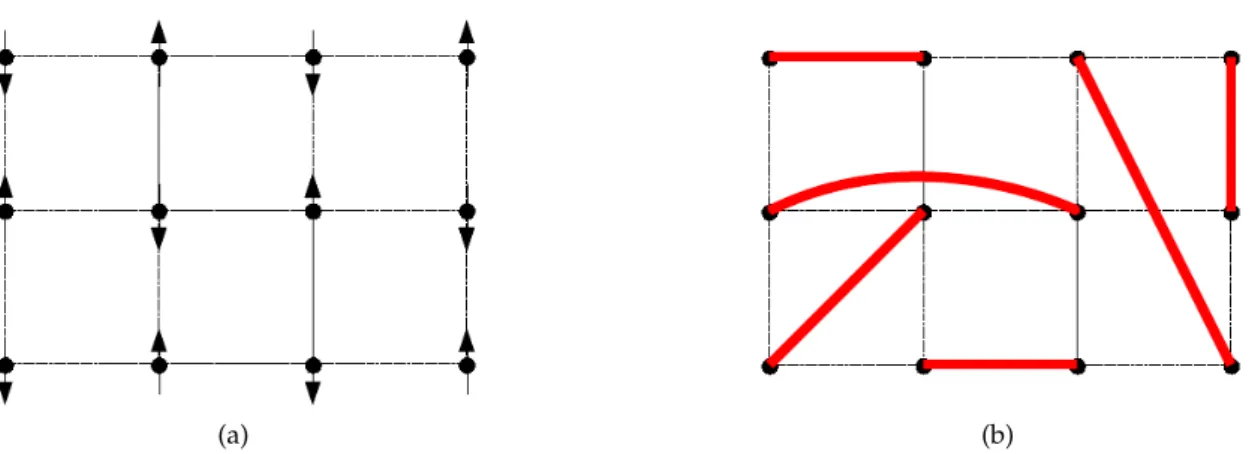
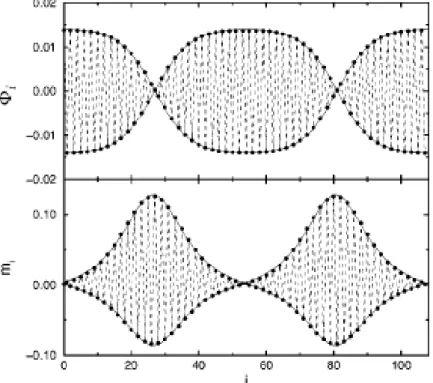
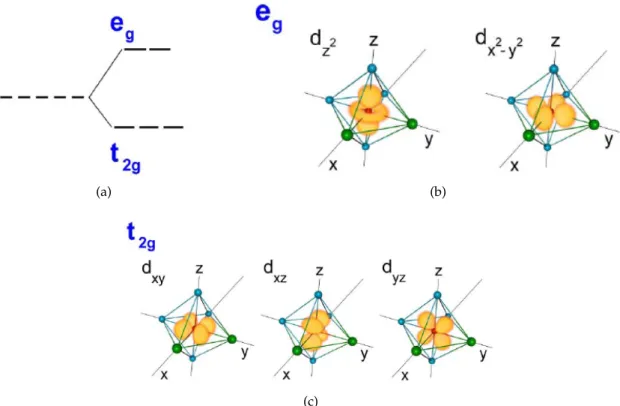
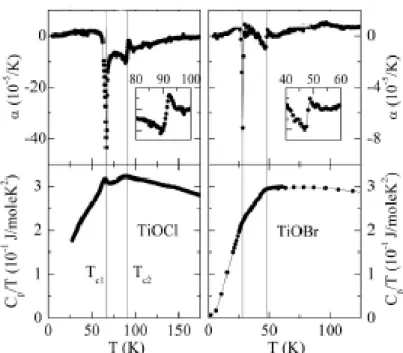
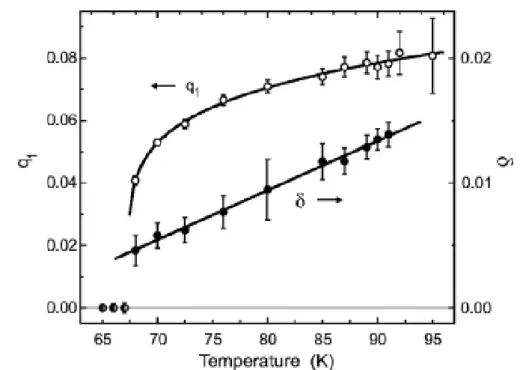
![Fig. 3.8: Displacements in the twofold spin-Peierls state. (Figure taken from Ref. [80]) The nature of the incommensurate phase between T c1 and T c2 was reported to be an incommensurate modulation of the twofold superstructure in the dimerized phase](https://thumb-eu.123doks.com/thumbv2/1library_info/3904578.1525124/30.892.290.598.164.457/displacements-peierls-incommensurate-reported-incommensurate-modulation-superstructure-dimerized.webp)
